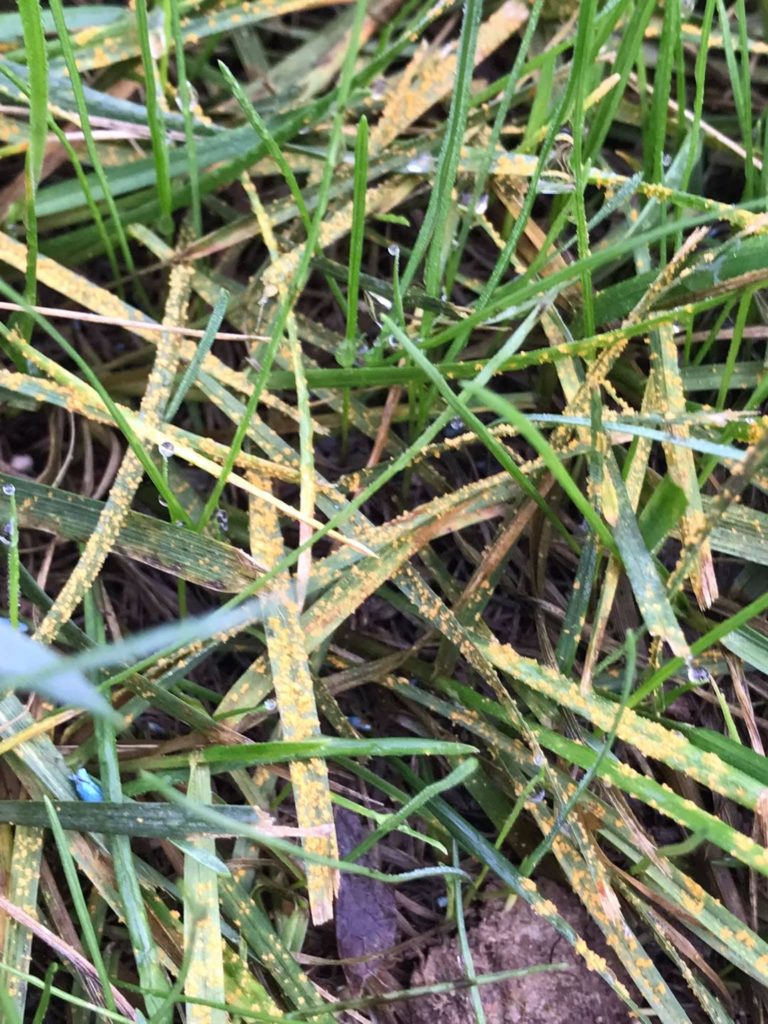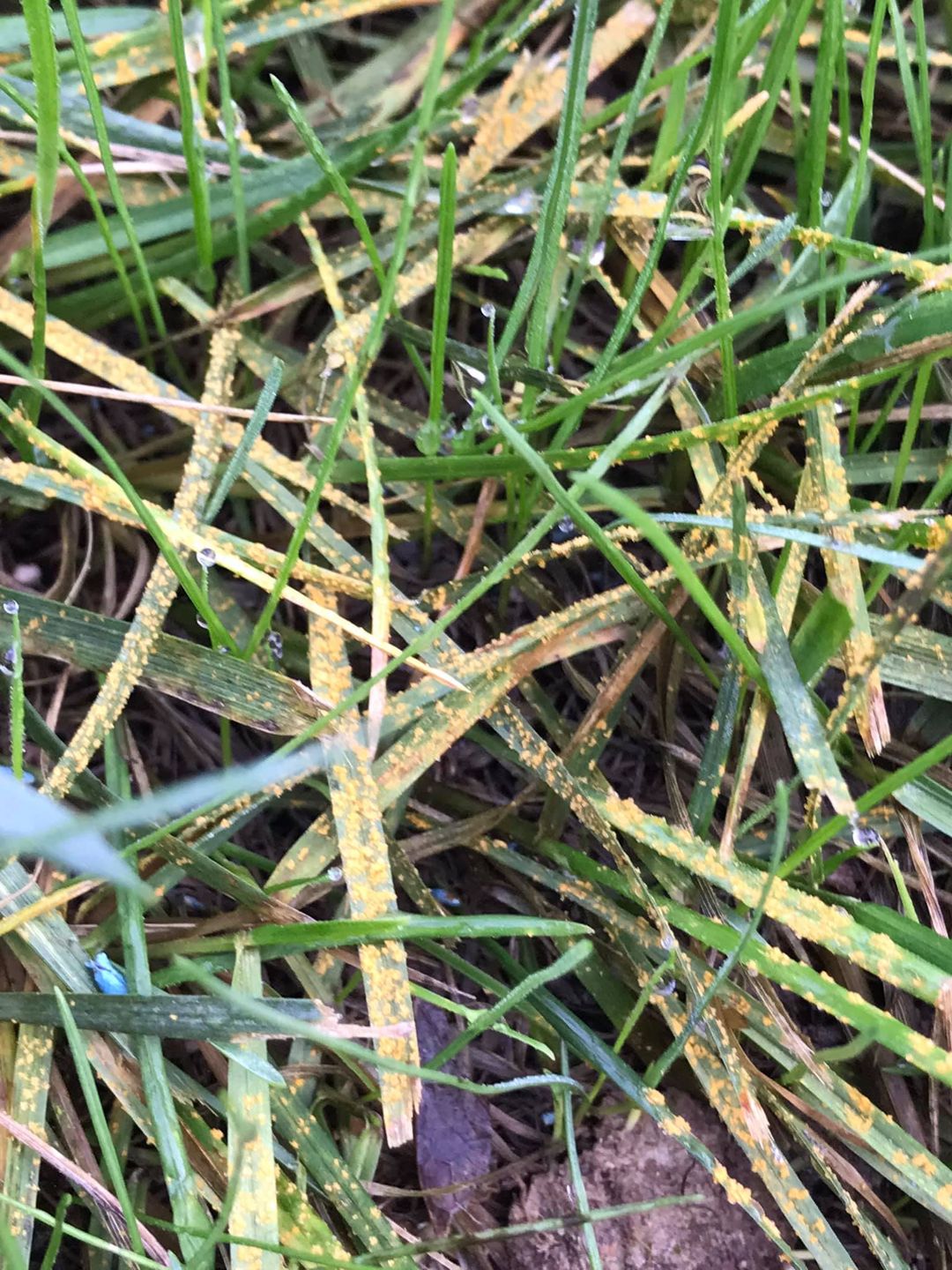LAWN PHIX PRO TIPS
I don’t see a lot of lawn rust around here, but when I do, there’s no mistaking it. Lawn rust is most common in early fall and can indicate low nitrogen. It is a powdery orange dust that can be easily wiped off from the grass blades (be careful as it can be tracked on your shoes). Underneath, the grass will likely be yellow, with chlorotic leaf tissue. In my experience, fast-release nitrogen clears up lawn rust, but you might want to consider Propiconazole at 2 oz. per gallon to completely treat this disease.
You don’t need to hire a professional gardener to identify one of the more common types of lawn disease. Lawn rust gets its name from the “rust-like” color that turns turf grasses and lawns in certain spots. But there’s some positive to this pesky lawn nuisance – and it’s the fact that it’s among the easiest diseases to treat.
In this post, we’ll discuss everything you need to know about lawn rust, including how to spot it, what causes it, and how to control and prevent it. Here’s a look:
Table of Contents
Lawn Rust Identification: How to Spot this Lawn Disease
Identifying this fungal disease is fairly easy – and for two main reasons. One is the appearance – as it takes on a yellowish-brown dust color. You may notice this orange-red color on your pant legs or shoes after walking over affected areas. You may also notice thinning or weakened grass blades in rust areas.
Two is the time of year when it’s most common, which is late summer or early autumn. We’ll get into more of what causes lawn rust at this time of the year in the next section.


What Causes Lawn Grass Rust Fungus?
Lawn rust is a fungal disease that can impact a lawn under the right conditions. It favors conditions such as low light, shorter days, cool nights, mild temperatures, and heavy dew. Frequent rainfall and humid conditions also tend to lead to grass rust problems. You can see why its growth is prevalent in the late summer and early fall.
However, perhaps the biggest reason why rust disease and other disease problems arise in lawns is due to one key factor: Nitrogen deficiency.
How to Control a Rust Lawn (and Other Lawn Diseases)
While we can’t control mother nature, we can take other matters into our own hands to eliminate this unsightly rust fungus, and prevent it from resurfacing in the future. The two biggest factors are applying fast-release nitrogen fertilizer and frequent lawn mowing.
How To Eliminate Lawn Rust/Grass Rust
The good news when it comes to eliminating and controlling lawn rust is that it’s among the easiest diseases to manage. Here’s a look at some lawn care tips to get your grass back to good health:
Mow Regularly
Mowing your lawn regularly (and bagging the clippings) will help prevent the spread of disease to other individual grass blades throughout your yard. Make sure to mow at a proper height and rinse off your lawn more and other lawn equipment after lawn care to prevent further spread.
Other Lawn Care Tips
There are several other ways to eliminate rust and maintain a healthy lawn. For instance:
- Water during the early morning hours so your lawn can adequately dry out. Remember, rust tends to thrive in wet weather.
- Thatch your turf: Rake and remove a thatch layer from your lawn if necessary. Thatch restricts air circulation and can prevent nutrients from reaching your grass roots.
- Aerate your lawn: Core aeration removes small plugs from your lawn, helping the roots receive more air and preventing soil compaction. In heavy clay soil, it’s suggested to aerate every year to reduce soil compaction. In sandy soil, aerating every 2-3 years is ideal.
Apply Nitrogen Fertilizer
A lack of nitrogen is the leading cause of lawn rust. That said, treating rust by applying fertilizer during the fall can help control rust, green up your grass, and keep your lawn healthy into the winter.
It’s worth noting that chemical control of rust fungus often doesn’t require the application of a lawn fungicide. Simply feeding your lawn as soon as the grass begins to rust and watering it according to the aforementioned tips in this section should be enough for it to begin greening up again.
Applying a nitrogen fertilizer with iron is a surefire way to make your grass pop if your lawn is turning yellow. I especially like Flagship 24-0-6 for this.
How To Prevent Lawn Rust/Grass Rust
As is the case with most turf problems and other diseases, the easiest way to control lawn rust is to prevent it from growing altogether. And keeping your grass well-fed with nitrogen-heavy fertilizer and enacting some of the lawn care tips that we mentioned in the above section is the ideal way to prevent the small yellowish spots on your lawn.
Want to know just how much nitrogen is in your soil? Conduct a soil test a few times a year. The results can help influence how you fertilize your lawn for the growing season.
It’s typically only necessary to apply fungicide in situations where you can’t control the environment to prevent fungal spores. These conditions include extensive shade or humid weather.
How to Repair Lawn Spots Damaged by Rust Diseases
If you catch rusting soon enough, feeding it and watering it is enough to reverse any potential damage that may occur. However, if it’s left untreated for too long, it can lead to some thinning of grass blades and overall weakening of the lawn. It can also spread so that it impacts more of your lawn. Finally, lawn rust can often be a gateway to other diseases and can lead to pest problems in lawns.
So how do you repair lawn spots? While grass should recover naturally after you take the necessary steps to control fungal growth, it can also be worth it to overseed the area – especially areas where the grass is thinning.
Lawn Rust Fungus FAQs
Will lawn rust go away on its own?
While this is always a possibility once the conditions that it thrives in subside, it’s always best to take measures into your own hands and control rust at the first sign of it. A lawn feeding, regular mowing, and more strategic watering can help that orange-red color disappear quickly from your lawn.
What grass types are most affected by lawn rust disease?
Rust disease tends to be most common beginning in August and into the early fall months. It most commonly impacts tall fescue and Kentucky bluegrass, and perennial ryegrass when mixed.

